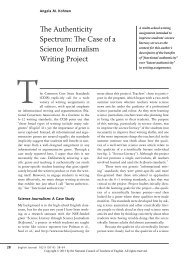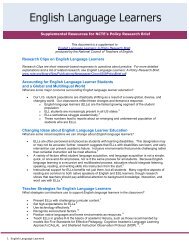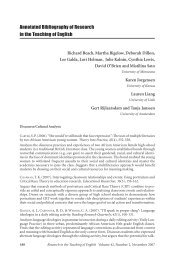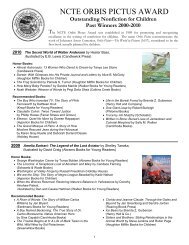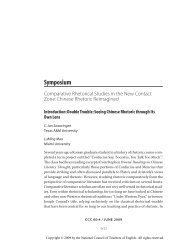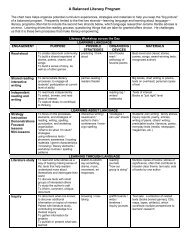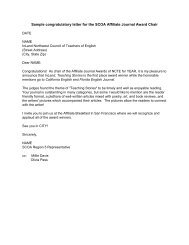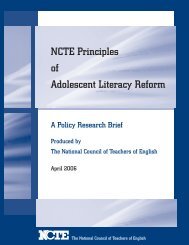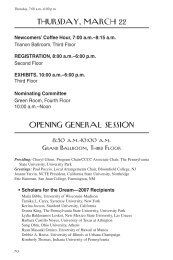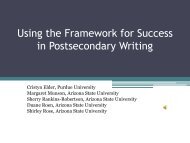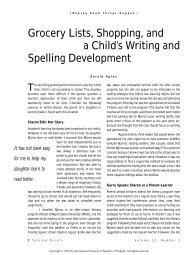Annotated Bibliography of Research in the Teaching of English
Annotated Bibliography of Research in the Teaching of English
Annotated Bibliography of Research in the Teaching of English
- No tags were found...
You also want an ePaper? Increase the reach of your titles
YUMPU automatically turns print PDFs into web optimized ePapers that Google loves.
222 <strong>Research</strong> <strong>in</strong> <strong>the</strong> Teach<strong>in</strong>g <strong>of</strong> <strong>English</strong> Volume 41 November 2006Reports <strong>the</strong> f<strong>in</strong>d<strong>in</strong>gs <strong>of</strong> one high-poverty elementary school’s change process as it moved froma rat<strong>in</strong>g <strong>of</strong> under-perform<strong>in</strong>g to mov<strong>in</strong>g <strong>of</strong>f <strong>of</strong> this list four years later. Focuses on <strong>the</strong> criticalelements <strong>of</strong> change required each year <strong>in</strong> <strong>the</strong> process, <strong>in</strong>clud<strong>in</strong>g attention to context, coherence,coach<strong>in</strong>g, and compassion. F<strong>in</strong>d<strong>in</strong>gs <strong>in</strong>dicate that change requires a district commitment tostability <strong>in</strong> <strong>the</strong> teach<strong>in</strong>g force and staff <strong>of</strong> <strong>the</strong> school over multiple years to allow a committedstaff to work through multiple years <strong>of</strong> learn<strong>in</strong>g and work on core issues. Coherence also <strong>in</strong>volvesa staff commitment to a common literacy framework used to guide literacy teach<strong>in</strong>g,learn<strong>in</strong>g, and assessments, and high-quality pr<strong>of</strong>essional development that spans multiple years.Coach<strong>in</strong>g by pr<strong>of</strong>essionals and peers was critical to success as well as ongo<strong>in</strong>g observations andfeedback from <strong>the</strong> pr<strong>in</strong>cipal. Attention to understand<strong>in</strong>g <strong>the</strong> challenges fac<strong>in</strong>g parents and <strong>the</strong>irchildren <strong>in</strong> this context and develop<strong>in</strong>g compassion for <strong>the</strong>se <strong>in</strong>dividuals was also key to <strong>the</strong>school’s success.GUTHRIE, J. T., WIGFIELD, A., HUMENICK, N. M., PERENCEVICH, K. C., TABOADA, A., & BARBOSA, P.(2006). Influences <strong>of</strong> stimulat<strong>in</strong>g tasks on read<strong>in</strong>g motivation and comprehension. The Journal<strong>of</strong> Educational <strong>Research</strong>, 99(4), 232-245.Investigates <strong>the</strong> use <strong>of</strong> stimulat<strong>in</strong>g tasks to <strong>in</strong>crease students’ situational <strong>in</strong>terest, dur<strong>in</strong>g <strong>in</strong>tegratedread<strong>in</strong>g and science <strong>in</strong>struction <strong>in</strong> 3rd grade. Two classrooms provided a high number <strong>of</strong>stimulat<strong>in</strong>g tasks, while two o<strong>the</strong>r classrooms provided a low number <strong>of</strong> stimulat<strong>in</strong>g tasks relatedto read<strong>in</strong>g. F<strong>in</strong>ds that a number <strong>of</strong> stimulat<strong>in</strong>g tasks <strong>in</strong>creased students’ motivation, which<strong>in</strong> turn was associated with <strong>in</strong>creased read<strong>in</strong>g comprehension on a standardized test.HYONA, J., & NURMINEN, A. (2006). Do adult readers know how <strong>the</strong>y read? Evidence from eyemovementpatterns and verbal reports. British Journal <strong>of</strong> Psychology, 97(1), 31-50.Investigates <strong>in</strong>dividual differences <strong>in</strong> read<strong>in</strong>g styles, and <strong>the</strong> degree to which competent adultreaders are aware <strong>of</strong> <strong>the</strong>ir read<strong>in</strong>g style. Participants read a long expository text while <strong>the</strong>ir eyefixation patterns were registered. Awareness <strong>of</strong> read<strong>in</strong>g behavior was assessed by a questionnaire.Identifies three types <strong>of</strong> readers: fast l<strong>in</strong>ear readers, slow l<strong>in</strong>ear readers, and topic structureprocessors. Readers were aware <strong>of</strong> <strong>the</strong>ir read<strong>in</strong>g speed, look-back, and re-read<strong>in</strong>g behaviors.Look<strong>in</strong>g back correlated positively with success <strong>in</strong> recall<strong>in</strong>g <strong>the</strong> ma<strong>in</strong> po<strong>in</strong>ts <strong>of</strong> <strong>the</strong> text.Concludes that look-back behavior is an <strong>in</strong>dication <strong>of</strong> strategic read<strong>in</strong>g.KAME’ENUI, E. J., FUCHS, L., FRANCIS, D. J., GOOD, R. III, O’CONNOR, R. E., SIMMONS, D. C., ET AL.(2006). The adequacy <strong>of</strong> tools for assess<strong>in</strong>g read<strong>in</strong>g competence: A framework and review. Educational<strong>Research</strong>er, 35(4), 3-11.Describes <strong>the</strong> Read<strong>in</strong>g First Assessment Committee’s (RFAC) framework for gaug<strong>in</strong>g <strong>the</strong> adequacy<strong>of</strong> tools available to assess read<strong>in</strong>g measures used with students <strong>in</strong> grades K-3. This<strong>in</strong>formation is <strong>in</strong>tended to provide state and local educational agencies with <strong>in</strong>formation thatmight help <strong>in</strong> <strong>the</strong> selection <strong>of</strong> read<strong>in</strong>g assessment <strong>in</strong>struments. Applies <strong>the</strong> framework to asample <strong>of</strong> tests, describ<strong>in</strong>g <strong>the</strong> selection and cod<strong>in</strong>g system. Provides f<strong>in</strong>d<strong>in</strong>gs centered on <strong>the</strong>“trustworth<strong>in</strong>ess” <strong>of</strong> assessments available to practitioners. Indicates that if high and rigorousstandards were used to assess trustworth<strong>in</strong>ess, <strong>the</strong>n very few tests would meet <strong>the</strong> m<strong>in</strong>imalrequirements. Suggests that <strong>the</strong> test developers use <strong>the</strong> RFAC’s documents to improve <strong>the</strong>irwork, and school districts use <strong>the</strong>se methods <strong>in</strong> select<strong>in</strong>g assessments.KLEIFGEN, J. (2005). ISO 9002 as literacy practice: Cop<strong>in</strong>g with quality-control documents <strong>in</strong> ahigh-tech company. Read<strong>in</strong>g <strong>Research</strong> Quarterly, 40(4), 450-468.Reports part <strong>of</strong> a larger ethnographic study <strong>of</strong> language and work <strong>in</strong> a small circuit-board manufactur<strong>in</strong>gplant with a racially, ethnically, and l<strong>in</strong>guistically diverse work force. Studied <strong>the</strong> preparationand use <strong>of</strong> quality-control documents, embedded with<strong>in</strong> a sociocultural perspective onliteracy, and collected observational and <strong>in</strong>terview data over two time periods. Found that workteams generally organize accord<strong>in</strong>g to ethnol<strong>in</strong>guistic background and <strong>of</strong>ten <strong>in</strong>voke local powerand agency <strong>in</strong> engag<strong>in</strong>g <strong>in</strong> quality-control documents.



